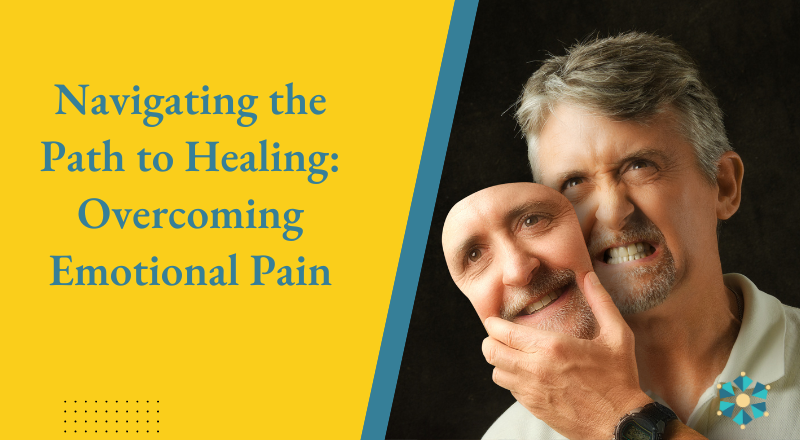
Emotional pain is a universal experience that can arise from various sources, such as loss, rejection, trauma, or the disappointment of unfulfilled goals. It can be deeply challenging and overwhelming, affecting every aspect of our lives. However, it’s important to remember that healing and growth is possible.
In this blog post, we will explore:
- Practical strategies and approaches to help you overcome emotional pain.
- The inherent challenges to implementing these strategies.
- Tips to embark on a journey of healing, growth and transformation.
1. Acknowledge and Validate Your Emotions:
The first step in overcoming emotional pain is to acknowledge and validate your feelings. It’s crucial to give yourself permission to experience and express the full range of emotions you’re going through. Whether it’s sadness, anger, anxiety or grief, allowing yourself to viscerally feel these emotions without judgment can be a cathartic and necessary part of the healing process. Emotions are not wrong, even if they are uncomfortable to feel. They are energies that can pass through your body, if you let them.
Challenge:
Unpleasant emotions can be difficult to handle, particularly when we don’t take the time to acknowledge and process them. Instead, we often ignore, suppress, or attribute them to external factors. Our instinctual response is to immediately take action and address the immediate issue. As a result, these patterns of responding to uncomfortable emotions can become ingrained habits that operate outside our conscious awareness.
Tip:
Dedicate time to confront your challenges and give proper attention to your emotions and worries, separate from the actual event. By acknowledging and validating these emotions as normal, though uncomfortable, they can move through you, allowing you to shift your focus away from emotional discomfort and problems towards your desired outcome. This approach is beneficial before and after encountering problems. Regularly practicing this strategy outside of problematic situations will enhance your capacity to process difficult emotions effectively as they arise.
2. Seek Support from Others:
Reaching out for support is a vital step in navigating emotional pain. Share your feelings and experiences with trusted friends, family members, a therapist or coach. Connecting with others who can provide empathy, understanding, and a listening ear – without engaging in your fears of being wrong or wronged – can offer the comfort and validation needed to ease your emotions and move towards growth and fulfilling solutions. Professionals can offer additional guidance and specialized techniques to facilitate healing and growth.
Challenge:
In times of duress, it is common to harbor the thought that you are the only one going through emotional strain or there is something wrong with you. This perspective prolongs pain and prevents individuals from seeking support, guidance, and resources from others. Rather than seeking helpful assistance, many individuals invest years in using ineffective strategies such as complaining, avoiding and attempting to resolve their issues on their own.
Tip:
Remind yourself, there is nothing inherently wrong with you. Emotional pain means you really care about something, and you are not clear and actively engaged in the solution yet. Working with others can be very rewarding, and you are capable of finding the right person to support you.
3. Practice Self-Care and Self-Compassion:
Self-care is crucial during times of emotional pain. Engage in activities that nourish your mind, body, and soul, such as practicing mindfulness or meditation, exercising, pursuing hobbies, or spending time in nature. It might also mean resting without self-criticism. Prioritize self-compassion by treating yourself with kindness, understanding, and patience. Remember that healing takes time, and allowing yourself to rest and recharge is essential.
Challenge:
The desire to fix a problem or help others is often stronger than the desire to care for yourself, yet solutions are more easily found and achieved when you are energized through self-care.
Tip:
If you don’t have the energy or motivation to get outside or take care of the things that are weighing you down, be compassionate towards yourself. Give yourself permission to rest, and during that time envision a time where a goal is fulfilled. The energy generated from imagining your goals (without worrying about how to make them happen) will eventually ignite your motivation and inspired actions. Enjoy the feelings your positive envisioning produces as enough for now.
4. Engage in Emotional Release Techniques:
Finding healthy outlets for emotional release can be highly beneficial. Explore techniques such as journaling, artistic expression, or engaging in activities that allow you to release pent-up emotions. Engaging in these practices can provide a sense of release, relief, and clarity.
Challenge:
Addressing difficult emotions without strategy can exacerbate their intensity and duration. Judging or labeling emotions as wrong or invalid hinders the process of acceptance and release.
Tip:
Find a coach, mentor or teacher who can support you with a comprehensive understanding of emotions and strategies on how to develop healthy habits of processing and releasing them.
5. Challenge Negative Thoughts and Reframe Perspectives:
Emotional pain often comes with negative thoughts and self-defeating beliefs. Challenge these thoughts by examining their validity and seeking evidence to counter them. Practice reframing your perspectives by intentionally focusing on positive aspects of your life, identifying lessons learned from difficult experiences, and embracing a growth-oriented mindset. This process can gradually shift your thinking patterns and cultivate resilience.
Challenge:
Negative thoughts are often countered with a positive thought and an inner struggle begins. Left unchecked, like a game of tug-of-war, more thoughts collect on each side of progress’s pros and cons team and intensify the pressure.
Tip:
Write down your thoughts. Doing so slows them down, allowing you to release negative thoughts and begin clarifying a winning solution. Then, add momentum to your clear solution by focusing on it and imagining its realization.
6. Cultivate Meaning and Purpose
Finding meaning and purpose in life can be a powerful force in overcoming emotional pain. Engage in activities that align with your values and put effort towards ideas that bring you joy and fulfillment. Volunteer, pursue creative endeavors, or engage in acts of kindness toward others. By focusing on something greater than yourself, you can find renewed hope, inspiration, and a sense of purpose that aids in the healing process.
Challenge:
Relying solely on external factors – such as exercise or helping others – to find purpose can often result in a heightened sense of emptiness, just as the opposite is true.
Tip:
Dedicate time for acknowledging and appreciating all of your inherent desires, self-expression, and unique perspectives. Additionally, being open to others and allowing them to share their strengths with you creates opportunities for growth, collaboration, and meaningful connections.
Overcoming emotional pain is a journey that requires patience, self-compassion, strategy and support. By acknowledging your emotions, seeking assistance, practicing self-care, challenging negative thoughts, exploring therapeutic techniques, and cultivating meaning and purpose, you can gradually heal and move forward. Remember that healing is a unique and personal process, and it’s essential to honor your own pace and progress. With time and effort, you can find confidence, growth, and renewed joy in life





